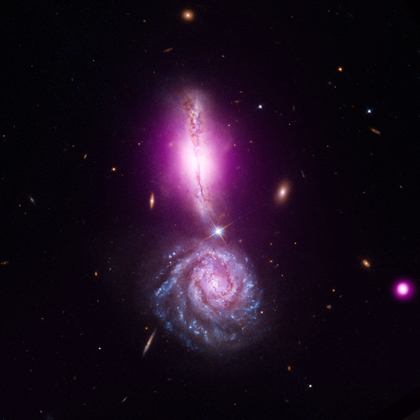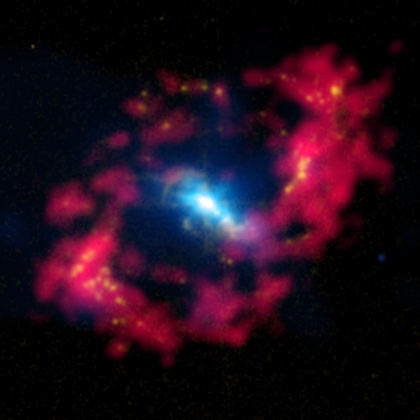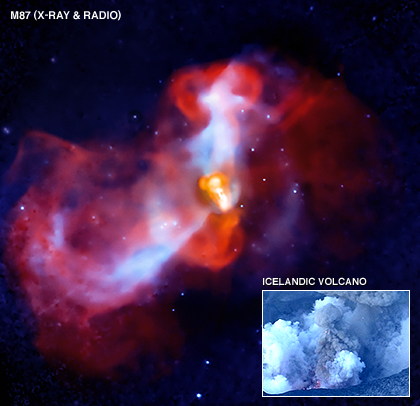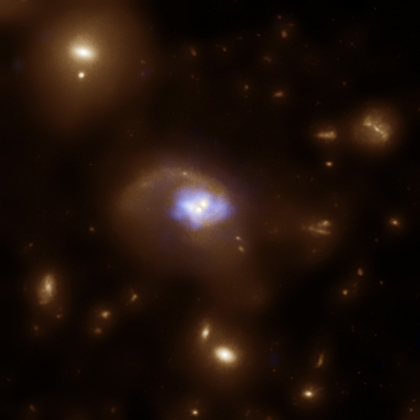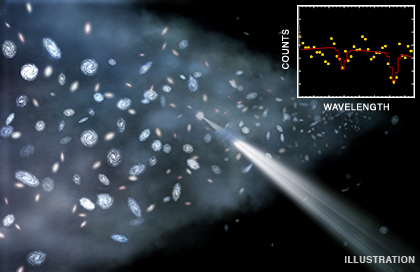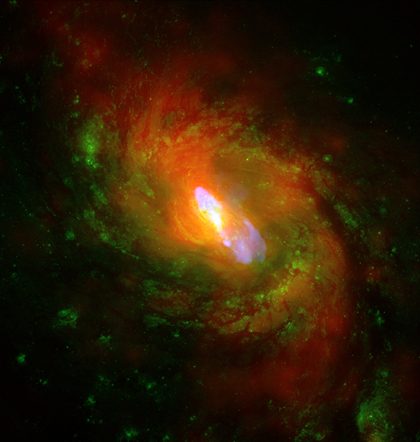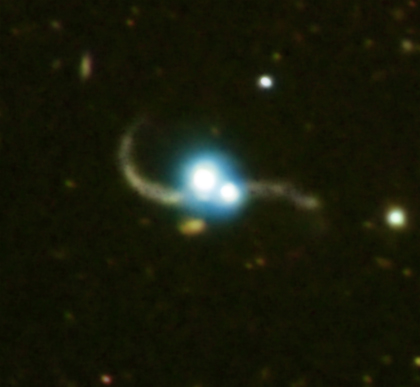Quasars & Active Galaxies
A Cosmic Exclamation Point
VV 340, also known as Arp 302, provides a textbook example of colliding galaxies seen in the early stages of their interaction. The edge-on galaxy near the top of the image is VV 340 North and the face-on galaxy at the bottom of the image is VV 340 South. Millions of years later these two spirals will merge - much like the Milky Way and Andromeda will likely do billions of years from now. Data from NASA's Chandra X-ray Observatory (purple) are shown here along with optical data from the Hubble Space Telescope (red, green, blue). VV 340 is located about 450 million light years from Earth.
An Active Black Hole in the "Eye of Sauron"
This composite image shows the central region of the spiral galaxy NGC 4151, dubbed the "Eye of Sauron" by astronomers for its similarity to the eye of the malevolent character in "The Lord of the Rings". In the "pupil" of the eye, X-rays (blue) from the Chandra X-ray Observatory are combined with optical data (yellow) showing positively charged hydrogen ("H II") from observations with the 1-meter Jacobus Kapteyn Telescope on La Palma. The red around the pupil shows neutral hydrogen detected by radio observations with the NSF's Very Large Array. This neutral hydrogen is part of a structure near the center of NGC 4151 that has been distorted by gravitational interactions with the rest of the galaxy, and includes material falling towards the center of the galaxy. The yellow blobs around the red ellipse are regions where star formation has recently occurred.
Galactic Super-volcano in Action
This image shows the eruption of a galactic "super-volcano" in the massive galaxy M87, as witnessed by NASA's Chandra X-ray Observatory and NSF's Very Large Array (VLA). At a distance of about 50 million light years, M87 is relatively close to Earth and lies at the center of the Virgo cluster, which contains thousands of galaxies.
A Black Hole Slingshot?
Evidence for a recoiling black hole has been found using data from the Chandra X-ray Observatory, XMM-Newton, the Hubble Space Telescope (HST), and several ground-based telescopes. A new paper reports that this black hole kickback was caused either by a slingshot effect produced in a triple black hole system, or from the effects of gravitational waves produced after two supermassive black holes merged a few million years earlier.
X-ray Discovery Points to Location of Missing Matter
Scientists have used NASA's Chandra X-ray Observatory and ESA's XMM-Newton to detect a vast reservoir of gas lying along a wall-shaped structure of galaxies about 400 million light years from Earth. In this artist's impression, a close-up view of the so-called Sculptor Wall is depicted. Spiral and elliptical galaxies are shown in the wall along with the newly detected intergalactic gas, part of the so-called Warm Hot Intergalactic Medium (WHIM), shown in blue. This discovery is the strongest evidence yet that the "missing matter" in the nearby Universe is located in an enormous web of hot, diffuse gas.
Winds of Change: How Black Holes May Shape Galaxies
This is a composite image of NGC 1068, one of the nearest and brightest galaxies containing a rapidly growing supermassive black hole. X-ray data from the Chandra X-ray Observatory are shown in red, optical data from the Hubble Space Telescope in green and radio data from the Very Large Array in blue. The spiral structure of NGC 1068 is shown by the X-ray and optical data, and a jet powered by the central supermassive black hole is shown by the radio data.
Quasar Pair Captured in Galaxy Collision
This composite image shows the effects of two galaxies caught in the act of merging. A Chandra X-ray Observatory image shows a pair of quasars in blue, located about 4.6 billion light years away, but separated on the sky by only about 70 thousand light years. These bright sources, collectively called SDSS J1254+0846, are powered by material falling onto supermassive black holes. An optical image from the Baade-Magellan telescope in Chile, in yellow, shows tidal tails - gravitational-stripped streamers of stars and gas -- fanning out from the two colliding galaxies.
An Intriguing Glowing Galaxy
Activity from a supermassive black hole is responsible for the intriguing appearance of this galaxy, 3C305, located about 600 million light years away from Earth. The structures in red and light blue are X-ray and optical images from the Chandra X-ray Observatory and Hubble Space Telescope respectively. The optical data is from oxygen emission only, and therefore the full extent of the galaxy is not seen. Radio data are shown in darker blue and are from the National Science Foundation's Very Large Array in New Mexico, as well as the Multi-Element Radio-Linked Interferometer Network in the United Kingdom.
Black Hole Outflows From Centaurus A
This image of Centaurus A shows a spectacular new view of a supermassive black hole's power. Jets and lobes powered by the central black hole in this nearby galaxy are shown by submillimeter data (colored orange) from the Atacama Pathfinder Experiment (APEX) telescope in Chile and X-ray data (colored blue) from the Chandra X-ray Observatory. Visible light data from the Wide Field Imager on the Max-Planck/ESO 2.2 m telescope, also located in Chile, shows the dust lane in the galaxy and background stars.
Welcome to the Virgo Cluster
We recently featured a composite image of Chandra and Hubble data of the object known as M87. This object, which gets its name from being the 87th object in Charles Messier's catalog, is the giant elliptical galaxy in what is known as the Virgo Cluster. If you are interested in astronomy, you have probably heard of the Virgo Cluster. What makes this cluster of galaxies so important that it seems like astronomers use every type of telescope to study it?

